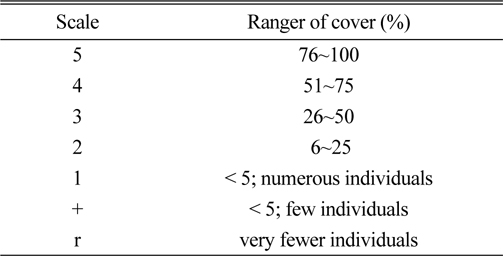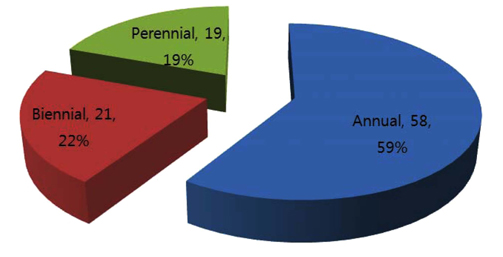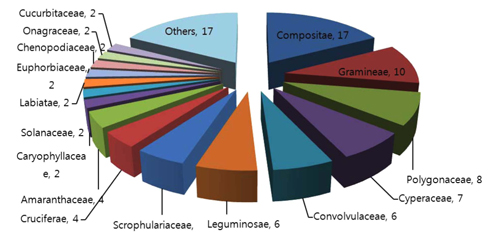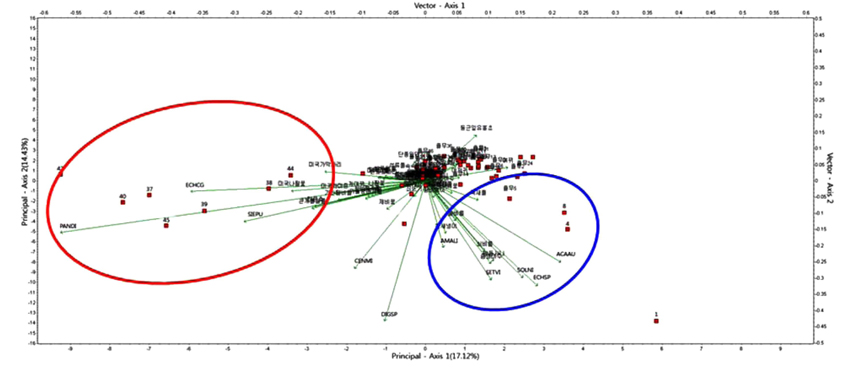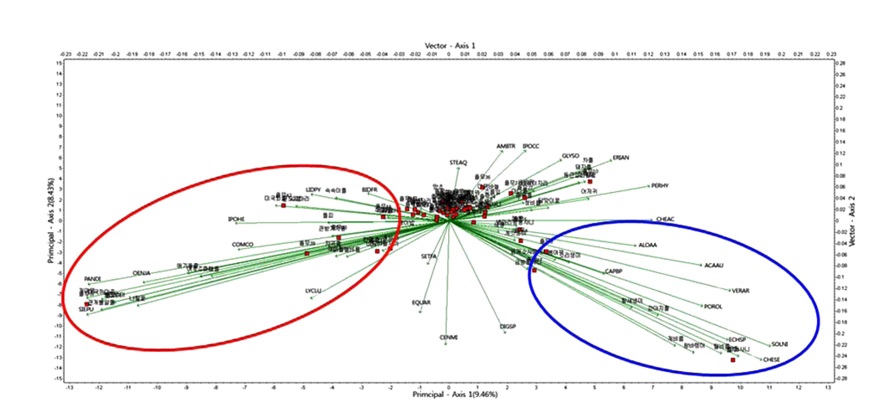



율무밭에 발생하는 잡초발생양상과 잡초로 인한 피해정도를 파악하여 율무밭 잡초방제의 기초자료로 활용하기 위하여 2013년 5월부터 9월까지 3회 조사하였다. 율무밭에 발생하는 잡초는 33과 98종으로 일년생잡초가 58종(59.2%), 월년생잡초 21종(21.4%) 그리고 다년생잡초가 19종(19.4%)이었다. 이 중 외래잡초는 31종이나 덩굴성 외래잡초인 둥근잎유홍초, 미국나팔꽃, 둥근잎나팔꽃 등의 발생이 많았다. 우점도가 높은 잡초로는 바랭이, 깨풀, 돌피, 쇠비름, 미국가막사리 등이었으며, PCA 분석한 결과, 3개 그룹(미국개기장 군락, 돌피-털진득찰 군락, 깨풀 군락)으로 나눌 수 있었다. 잡초방임구에서 율무의 수량감소는 잡초관리구에 비하여 60% 감소하였다.
This study was conducted in order to utilize the basic data for weed control by surveying the occurrence of weed species and the degree of damages caused by those weeds occurred in cultivated
우리나라에서 율무에 대한 첫 기록은 1236년에 발간한 향약구급방(鄕藥救急方)이라고 한다(Kim, 2012). 율무를 한약명으로는 의이(薏苡) 또는 의이인(薏苡仁)이라고 부르며, 여러 가지 약리작용과 식용으로 널리 이용되고 있다. 대표적으로 율무차, 율무죽 등이 건강식품으로 각광을 받고 있으며(Gwak et al., 2012), 곡물임에도 불구하고 단백질이 16%정도 함유되어 있어 건강식으로 좋은 것으로 알려져 있다(Kim, 2012). 율무쌀에 0.25% 함유된 Coixenolide 성분이 면역세포 활성에 영향을 미쳐서 항종양효과가 있는 것으로 보고되어 있다(Ryu, 2008; Ryu and Kim, 2005).
율무에 대한 연구는 율무 계통별 품질 특성(Yi et al., 2007), 재식밀도 및 질소질 비료 투입에 의한 수량 효과(Yi and Yoon, 1994; Kang et al., 2000), 토양수분조건에 따른 생육특성(Kim et al., 1997; Kim et al., 1996) 등이 보고된 바 있다. 율무밭에서 잡초에 대한 보고는 율무와 잡초간의 경합시험으로 인위적으로 조성된 피, 바랭이, 명아주, 쇠비름 4종에 대하여 실시한 바 있다(Yoon et al., 1999).
항비만, 항염증, 혈당 및 콜레스테롤 감소 효과, 항산화, 항치매성 등의 기능성이 보고된(Gwak et al., 2012; Kwak et al., 2004; Park, 2005; Seo et al., 2009) 율무가 소면적이지만 고소득으로 다시 각광을 받고 있다. 이들 율무밭에서 자연적으로 발생하는 잡초에 대한 정확한 정보와 피해 정도가 조사된 바 없다. 따라서 율무밭에 발생하는 잡초발생과 잡초로 인한 피해 정도를 파악하여 율무밭 잡초방제의 기초자료로 활용하기 위하여 연구를 수행하였다.
율무밭에 발생하는 잡초는 2013년 5월부터 9월까지 총 3회 실시하였다. 조사지역은 주산단지인 경기도 연천지역을 대상으로 하였으며, 조사지점은 45지점, 면적은 86,490 m2이었다. 발생잡초는 각 시기별로 Braun-Branquet (1964)에 의한 7개 등급(r, +, 1, 2, 3, 4, 5)을 기준으로 피도(被度)를 조사하였다(Wikum and Shanholtzer, 1978). 각 단계별 잡초발생 정도는 Table 1 및 Fig. 1과 같다.
[Table 1.] Braun-Branquet scale by cover-abundance (Braun-Branquet, 1964).

Braun-Branquet scale by cover-abundance (Braun-Branquet, 1964).
잡초조사 결과는 국가표준식물목록(KNA, 2007)에 의거하여 목록을 작성하였고, 외래잡초는 한국귀화식물 원색도감(Park, 2009)에 의해 표기하였다. 출현한 잡초종에 대해서는 Raunkiaer(1934)의 생활형을 기준으로 일년생과 다년생을 구분하였고 과별 분포 비율을 산정하였다. 잡초의 우점 순위를 알아보기 위하여 중요치(IV)분석을 실시하였다(Curtes and Mc Intosh, 1950).
조사지역간 잡초종의 출현에 따른 차이를 파악하기 위하여 Ordination 분석은 각각PCA (principal component analysis) 공변량(covariance)과 연관분석(correlation)을 실시하였다(Legendre and Legendre, 1998). 공변량과 연관분석의 자료분석은 Seaby and Henderson (2007)의 Community analysis package 4.0 for window program을 이용하였다.
잡초에 의한 율무 피해조사는 경기도 농업기술원 소득자원연구소에서 실시하였다. 2013년 6월 6일에 재식거리 90×30 cm 간격으로 파종한 율무(품종: 조현)를 대상으로 잡초관리구와 방임구를 두고 9월 27일에 수확하여 분얼수, 수량 등을 비교하여 피해 정도를 확인하였다.
율무밭에서 발생하는 잡초는 32과 98종(Table 2)으로 일년생잡초가 전체의 59.2%를 차지하는 58종, 월년생잡초가 21.4%로 21종, 그리고 다년생잡초가 19.4%로 19종이었다(Fig. 2). 이 중에서 외래잡초는 31종으로 잡초 전체의 31.6%를 차지하며, 둥근잎유홍초, 미국가막사리, 미국나팔꽃, 단풍잎돼지풀 등이 발생하였다. 이 중 외래잡초의 하나인 단풍잎돼지풀은 파주, 의정부, 연천 등 경기 북부지방에서 많이 발생하며, 꽃가루와 급격한 번식으로 환경유해식물로 지정되어 관리가 필요한 잡초로 알려져 있다(http://www.invasive.org). 우리나라에서는 2012년 12월 31일자로, 외래생물 중 생태계의 균형을 교란할 우려가 있는 생물 등에 대하여 ‘생물다양성 보전 및 이용에 관한 법률’(2013년 2월 2일 시행)에 의해 지정된 총 18종의 생태계 교란 생물에 포함되었다(Kim et al., 2013). 특히 현지조사 결과, 율무는 도로변과 인접한 밭에서도 많이 재배하는 관계로 도로변에 발생한 단풍잎돼지풀 종자가 율무밭으로 유입되어 문제가 되고 있었다.
[Table 2.] Occurrence of weed flora in Coix lacryma-jobi var. mayuen fields.

Occurrence of weed flora in Coix lacryma-jobi var. mayuen fields.
과별로 잡초발생 상황을 보면(Fig. 3), 국화과 17종 > 벼과 10종 >마디풀과 8종 > 사초과 7종 > 메꽃과 6종 > 콩과 6종 등이었으나, 상대적으로 메꽃과의 발생이 많아 덩굴로 인하여 후기에 쓰러짐의 원인이 되었다. 밭잡초에서 과별 잡초발생상황은 국화과, 벼과, 마디풀과 순이라는 Park et al.(2003)의 보고와 유사한 경향을 보였다.
율무밭에 발생하는 잡초 중 중요도(우점도)가 높은 상위 10종은 바랭이, 깨풀, 돌피, 쇠비름, 미국가막사리, 둥근잎 유홍초, 닭의장풀, 황새냉이, 여뀌, 돌콩 순이었다(Table 3). 율무는 옥수수와 같이 장마 후 생육이 왕성하므로 초기에만 잡초와 경합에 유리하도록 관리를 해주면 캐노피(Canopy)가 형성되어 후기 잡초는 문제가 없을 것이다. 그러나 현지조사 결과, 파종복토 후 적용 제초제를 살포하지 않았거나 파종시기 일실로 제때 파종하여 관리하기 않을 경우에는 많은 잡초가 발생하였다.
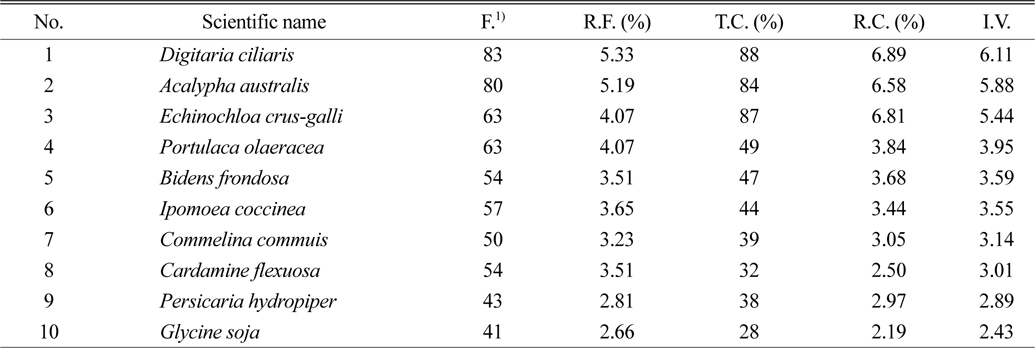
Occurrence of weed flora ordered by importance value in Coix lacryma-jobi var. mayuen fields (top 10 weeds).
PCA(principal component analysis) 분석은 군집생태에서 군락을 구성하는 방형구의 초종간의 분석이 우수하여 생태학에서 주로 이용된다(JanžekoviË and Novak, 2012). 율무밭에 발생한 잡초를 대상으로 PCA 공변량을 분석한 결과, 조사지역 내 율무밭 대표 잡초군락은 미국개기장 군락(
PCA 연관분석은 군락 분석된 집단간의 연관성을 확인하여 이들 군락간의 상관관계를 보다 명확하게 유형화시키는 분석방법이다(Legendre and Legendre, 1998). 앞서 조사지역 내 율무밭의 PCA 공변량 분석결과는 미국개기장, 돌피-털진득찰, 깨풀에서 높은 피도값을 보였으며, 이들이 대표군락으로 분석되었다. 이들 지역으로 출현한 모든 초종을 PCA 연관분석(correlation)을 해본 결과, 대표군락을 보인 3개 군락은 미국개기장 군락(
우리나라 밭에서는 메꽃과 잡초의 발생이 아주 적은 것이 일반적인데(Park et al., 2003), 경기도 연천지방 율무밭에서는 외래잡초 중에서 메꽃과 잡초인 둥근잎유홍초, 미국나팔꽃, 애기나팔꽃 등 6종이 발생되어(Table 1, 4) 그 원인을 규명할 필요성이 제기되었다. 현지 조사당시(2013년 6월), 농가에서는 마을별로 유기질 퇴비를 공동 구매한 후 율무밭에 살포하는 광경을 목격하였다. 이 유기질 퇴비가 시용된 밭에서는 메꽃과 잡초가 발생되어 유기질 비료를 통하여 이들 잡초가 확산된 것으로 추정된다.
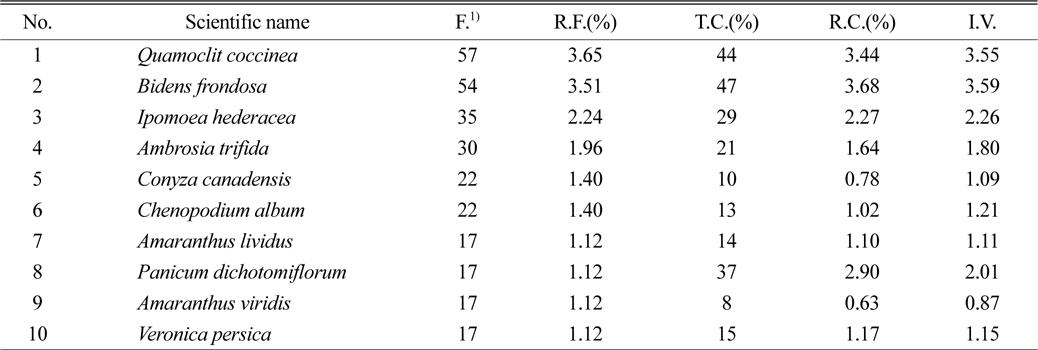
Occurrence of exotic weed flora ordered by importance value in Coix lacryma-jobi var. mayuen fields(top 10 weeds).
메꽃과 잡초는 율무 생육 중에도 계속 생장하여 덩굴이 초장 끝에 까지 뻗어 나와 율무끼리 서로 엉키게 만들고 수확기인(9월)에 비가 올 경우 율무 쓰러짐의 원인을 제공하고 있었다. 후기에 쓰러지면, 콤바인에 의한 수확작업이 곤란해질 뿐만 아니라 수량감소로 이어질 수 있어 방제가 꼭 필요한 잡초 중의 하나이다. 이들 메꽃과 잡초의 확산을 막기 위해서는 공동 구매한 유기질 퇴비를 23개월 동안 후숙시켜 잡초종자가 사멸된 후에 밭에 살포하는 것이 타당할 것으로 판단된다(Kang et al., 2007).
율무밭에 발생하는 잡초는 위에서 언급한 바와 같이 33과 98종이다. 이들 잡초발생을 사전에 억제할 수 있는 방안으로는 파종복토 후 토양처리제를 살포하는 것이다. 즉 율무에 적용 가능한 리뉴론·티오벤카브유제 등 2종을 파종복토 후 토양처리하는 것이다. 현지 조사당시(2013년 6월, 7월), 율무밭에 발생하는 잡초를 보면, 토양처리제를 살포한 농가는 10%미만으로 많은 잡초가 발생하고 있었다.
대부분의 농가에서는 토양처리제를 살포하지 않고 비산방지를 위한 깔대기를 씌운 후 비선택성 제초제를 처리하거나 일부 광엽잡초는 벼과작물과의 선택성을 이용한 경엽처리제를 살포하였다. 선택성 경엽처리제를 살포하는 것은 이론적으로는 합당하나 미등록 약제를 살포하는 것으로 이들 약제를 농약품목으로 등록시켜 양성화하는 것이 시급하다고 판단되었다.
잡초에 의한 율무의 피해 정도는 율무 파종 110일 후에 실시하였다. 시험구에 발생된 잡초로는 가을강아지풀, 돌피, 미국개기장, 가는털비름, 한련초, 석류풀, 명아주 등이었다. 이들 잡초에 의해, 잡초방임구는 잡초관리구에 비하여 포기당 분얼수, 주당 등숙립수가 월등히 떨어져서 최종수량은 60%나 감소되는 양상을 보였다(Table 5). 그러나 상품성까지 고려한다면, 90%이상 잡초에 의해 율무가 피해를 받았다고 판단되므로 적용 제초제를 이용한 효율적인 잡초관리를 통해 해결될 수 있을 것으로 사료된다.

Comparison of Coix lacryma-jobi var. mayuen yield’s between weed management plots and no weeding plots.
